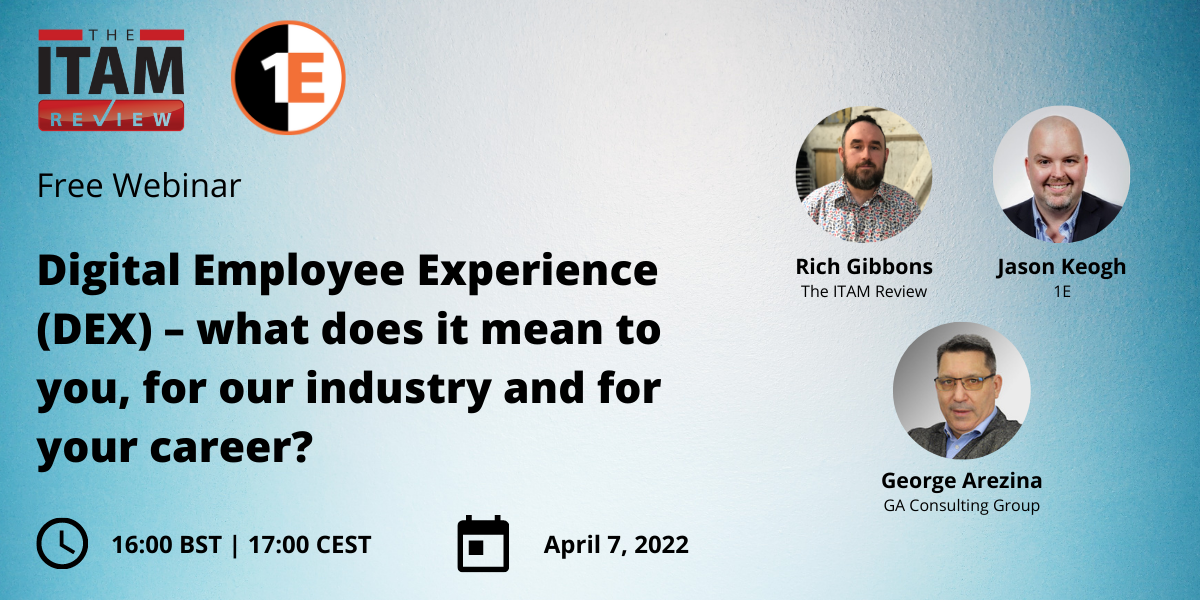Digital Employee eXperience (DEX) and ITAM – a future partnership?
This article was written in conjunction with Jason Keogh, Field CTO, at 1E.
DEX. Digital Employee eXperience. It’s not a new buzzword – it is THE new buzzword. You may not have heard of it but, if you work in ANY area of IT, DEX is a mainstay of your job. What could a partnership between Digital Employee eXperience (DEX) and ITAM look like?
Life before DEX
The “old” way was that IT people did things to make IT work. DEX is the leading edge of a school of thought which says that the focus of IT people should be ensuring employees can make the business work. Better, faster, more consistently, with less interruption and with as little “friction” as possible.
Friction is what happens when, as an employee, your IT experience gets in the way – prevents you from doing something rather than enables you to do something. Friction is bad.
IT Asset Management traditionally has 3 main functions:
- Ensure that the business has access to the correct IT Assets at the right time – with those assets being Software or Hardware, leading to SAM (Software Asset Management) or HAM (Hardware Asset Management)
- Ensure the business does not face excess cost or risks, in particular relating to software licenses management (SLM)
- Ensure the business monitors and “right-sizes” usage of assets, typified by the monitoring of software use and implementation of “Reclaim” strategies to remove unused, unnecessary software
ITAM, along with IT Security in some organisations, have a reputation of being “Doctor No” – the default attitude being that users get a defined set of apps and if they need anything beyond that, they should not have it, or have to jump through hoops to get it.
A changing attitude
This attitude is slowly changing – and the focus from the CEO, CIO, and down on empowering employees to get their jobs done with the tools they require is seeing it be called into question more and more. To ensure a positive Digital Employee eXperience (DEX), all efforts should be made to facilitate reasonable user requests for access to tools which make them better at doing their jobs.
This can fly in the face of common SAM practices like minimising the number of conflicting tools that do a similar job – why do we need eighteen different image manipulation tools, can we get by with two, or even a single one? If you increase the volume, you can often reduce the unit cost – so gain economies of scale, have fewer vendors to manage and less software variance to update, patch, secure by limiting spread and so on.
Yet we see more and more employees being permitted to have, and perhaps even purchase on company cards, small volume or individual subscriptions and licenses to tools with functions broadly similar to existing products available centrally. Is DEX to blame?
HAM too has some old adages which are challenged by DEX. We purchase laptops for users every X years (four, five?). We keep them under support and as they break, we repair or replace them. We have a small set of approved devices and allocate them mainly based on user job roles.
BUT – what if a user, based on their particular use of their device, has a poor experience because it is under-powered for them? Equally there may be other users, with more powerful devices, who barely stress the hardware. Can we identify and perhaps switch those devices around?
Rather than replacing depreciated devices because they have reached a certain age – can we “sweat” those assets to reduce purchase volumes based on user experience. If the device is stable, and the user isn’t being slowed or experiencing “friction” with it – do we really need to replace it?
Replacing devices based on intelligent factors such as performance, stability, battery health, etc. is more sensible than simply basing changes on age.
DEX tooling, which helps identify these quantifiable metrics, and also can monitor end-user “sentiment” – opinion based qualitative data – can be a much better guide to when to replace a device than by counting how many circuits it has made of the sun.
So – as organisations seek to embrace DEX, it offers opportunities and challenges to several ITAM practices across SAM and HAM.
The DEX + ITAM opportunity
DEX is an opportunity for ITAM teams to redefine their position in the organisation. Just as IT evolves from saying “No” to being an enabler, so can ITAM. Our tools provide data useful to stakeholders with primary responsibility for DEX. We can help users find the apps they need by providing insight into the apps in use already across a particular category. And we can help define hardware and software strategy by providing key lifecycle metrics such as warranty information and end-of-life dates.
Next steps
Join us for a webinar on April 7th to learn more about Digital Employee eXperience (DEX) and ITAM – what does it mean for you, for our industry and for your career?

Guest speakers:
- Jason Keogh: ITAM, IT Security and DEX industry veteran, editor of ISO 19770-3 and Field CTO of DEX leader 1E,
- George Arezina: IT and ITAM industry veteran with 15+ years of experience leading ITAM in global enterprises
Related articles:
- Tags: DEX · Digital Employee Experience · HAM · SAM
About Rich Gibbons
A Northerner renowned for his shirts, Rich is a big Hip-Hop head, and loves travel, football in general (specifically MUFC), baseball, Marvel, and reading as many books as possible. Finding ways to combine all of these with ITAM & software licensing is always fun!
Connect with Rich on Twitter or LinkedIn.
